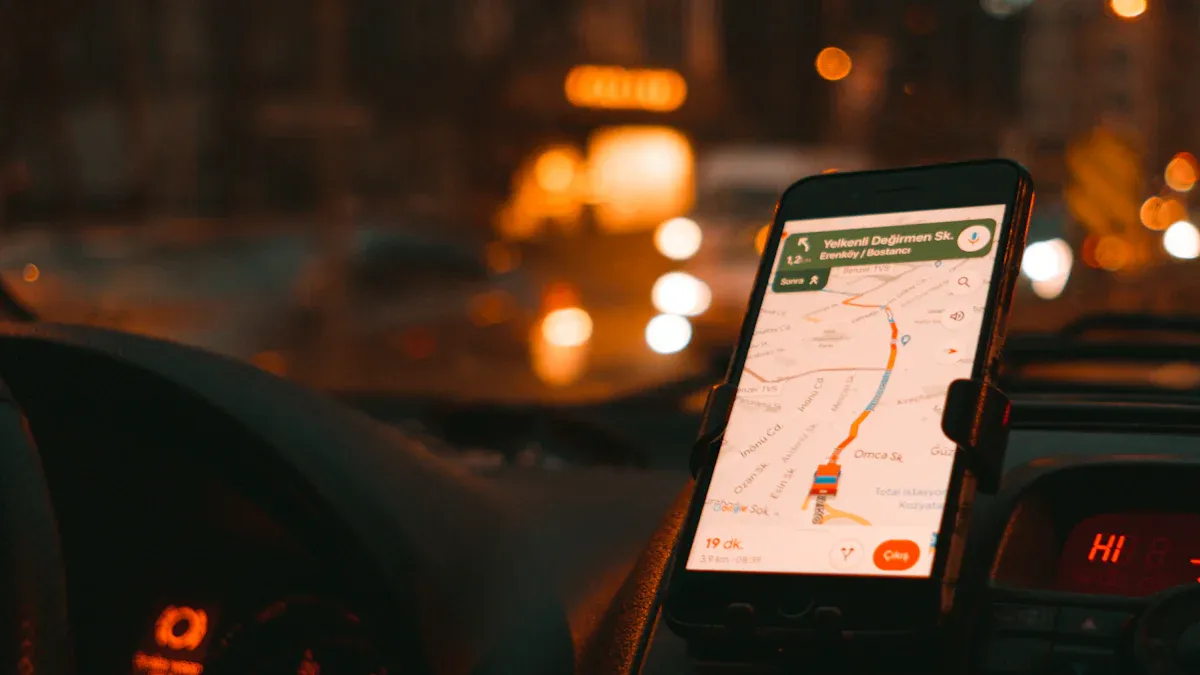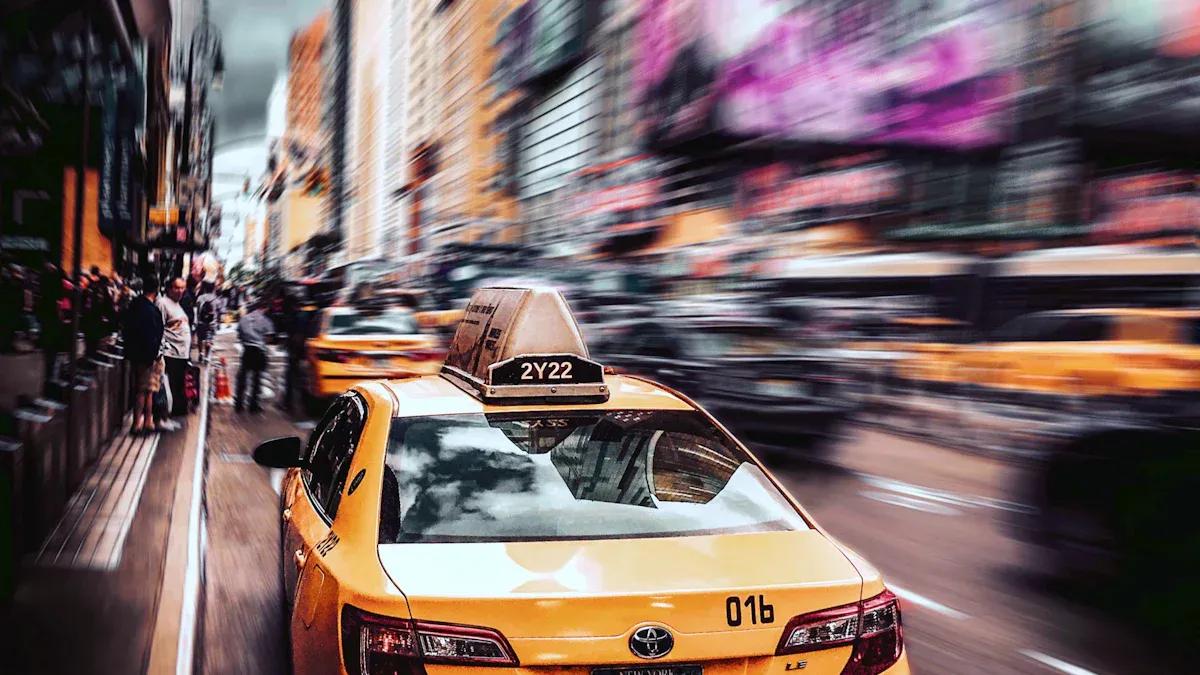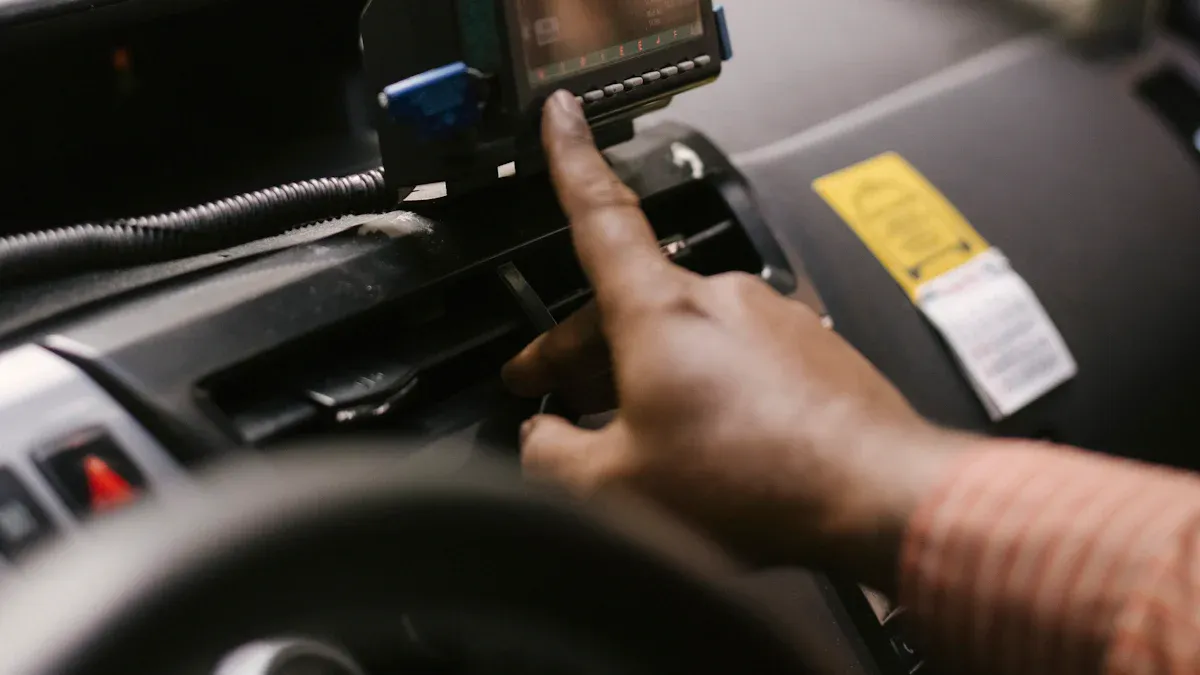
A taxi drives into a busy city area, and its digital sign quickly changes to show an ad for a close restaurant. GPS location-triggered taxi advertising uses GPS and geofencing to know when a ride-hailing car goes into certain areas. The system then sends special ads right away. Ride-hailing drivers, passengers, and operators all see ads that fit them better. Geofencing technology helps ride-hailing services show more local ads, making every taxi ride worth more for advertisers and customers.
Key Takeaways
GPS location-triggered advertising uses GPS and geofencing. It shows ads that match where taxis are right now.
Taxi operators make more money by showing local ads. These ads fit the taxi’s route and bring in more advertisers.
Advertisers reach the right people at the right time. This makes their ads work better and easier to track.
Passengers see helpful ads and special offers based on location. These ads make their rides more fun.
Privacy matters. Taxi apps keep user data safe. Passengers can choose how their information is used.
GPS Location-Triggered Taxi Advertising

What It Is
GPS location-triggered taxi advertising uses smart technology to show ads based on where taxis go. The system uses GPS tracking, geofencing, and digital screens to display ads that fit the taxi’s spot. Taxi operators put tablets or media players inside their cars. These devices have GPS and 4G modules, so they work well and save energy. The system connects to the internet with Wi-Fi or 3G/4G. This lets it update ads and get live data right away.
Taxi companies use special management systems to control ads and watch data. These systems work with mapping services like Google Maps. This helps set up taxi routes and show ads for local deals, next stops, or real-time news. The technology makes it easy to do location-based marketing, even when ride-hailing routes change a lot.
How It Works
Geofencing makes invisible lines around places like airports, malls, or fun spots. When a taxi with GPS goes in or out of these areas, the system notices. The GPS location-triggered taxi advertising platform then shows digital ads, like a restaurant ad or a discount message for riders.
GPS keeps track of where taxis and ride-hailing users are in real time. When a taxi enters a geofenced area, the system sends special marketing messages. Passengers may see ads for stores nearby or get offers for their stop. This way, taxi companies can show ads that fit the location, making marketing better for advertisers and more interesting for riders. GPS and geofencing together help ride-hailing services give timely, useful ads during every ride.
Main parts of gps location-triggered taxi advertising:
Tablets or media players with GPS and 4G modules
Wi-Fi or 3G/4G for updates
Sync with mapping services
Backend management for ads and data
Technology in Taxi Advertising

GPS Tracking
GPS tracking is very important for taxi advertising. Each taxi has a GPS module to find its exact spot all the time. Taxi apps use this data to watch where taxis go and stop. This helps taxi operators know when a car enters or leaves an area. GPS tracking also lets taxi apps learn about how people move and traffic. With this information, taxi companies can make routes better. They can also make sure ads reach the right people at the right time. GPS tracking gives the exact location needed for geofencing marketing.
Geofencing
Geofencing marketing uses fake borders to pick where ads show up. Taxi apps make these borders with geofencing technology. They can draw circles or shapes around places like airports or malls. A geofence can be as small as a quarter mile or much bigger. Taxi operators often use many small geofences instead of one big one. This helps them reach more people and compare results. Geofencing works best when the area is close to a business. Taxi apps use data to decide where to put geofences. They do not just guess where people are.
Tip: Geofencing marketing needs to be the right size. If it is too small, not many people see the ad. If it is too big, ads may not matter to people.
Advertisers look at where people live, work, and shop to set up geofencing marketing. They use location history to make targeting better. They also leave out places that do not matter to save money. Taxi apps can target places like other taxi stands or busy areas. They check results often and test different ideas to improve ads. Privacy is very important, so taxi apps must be clear and let users opt out.
Ad Delivery
Ad delivery in taxis needs hardware and software to work together. Most taxi apps use LCD screens on headrests or dashboards. These screens are usually 9 to 10.1 inches big. They can show videos and pictures. LCD screens are used most in taxi digital signs. They are strong and work well in cars. Taxi apps connect these screens to the internet with Wi-Fi, LAN, or 4G. This lets them change ads from far away and update them fast.
Taxi apps use mapping software to match ads with the taxi’s spot. When a taxi goes into a geofenced area, the system shows ads for nearby places or events. Geofencing marketing makes sure passengers see ads that fit where they are. Taxi apps can also show special offers or event news based on location. This makes ads more useful for riders and advertisers.
Note: GPS tracking, geofencing marketing, and digital signs help taxi apps show the right ads at the right time. This makes rides better for passengers and helps taxi companies earn more money.
Workflow Overview
Step-by-Step Process
Taxi apps use a clear process to deliver GPS location-triggered ads. This process starts when a ride-hailing driver picks up a passenger. The taxi has a digital screen and a GPS device. The GPS device tracks the taxi’s location at all times. Taxi apps connect this data to geofencing software. The software draws digital borders around key places, such as airports, shopping centers, or busy streets.
When the taxi enters a geofenced area, the system sends a signal to the digital screen. The screen then shows an ad that matches the location. Taxi apps update these ads in real time. The process repeats as the taxi moves through different geofenced zones. Ride-hailing services use this method to make sure ads stay relevant. Taxi operators can check reports from taxi apps to see which ads work best.
Note: Geofencing helps taxi apps target ads with high accuracy. This makes each ride more valuable for advertisers and passengers.
Example Scenario
A ride-hailing driver starts a shift in the morning. The taxi leaves a quiet neighborhood and heads toward a busy part of the city. As the taxi crosses into a geofenced area near a popular coffee shop, the digital screen changes. The ad now shows a special offer for coffee and breakfast. Passengers see the ad and may decide to visit the shop.
A Brooklyn coffee shop in Williamsburg used this approach. The shop set up geofencing for taxi top ads in trendy neighborhoods like Greenpoint and DUMBO during the morning rush. The campaign led to a 40% increase in foot traffic. About 15% of customers mentioned the taxi ad, and over 200 new Instagram followers came from QR code scans. This example shows how taxi apps and geofencing can boost local business and engage ride-hailing users.
Taxi apps make it easy for ride-hailing services to deliver the right message at the right time. Geofencing ensures that ads match the location, making each taxi ride a chance for smart marketing.
Benefits and Challenges
For Taxi Operators
Taxi operators can make more money with geofencing marketing. They show ads that fit each place the taxi goes. This makes ads worth more and brings in more advertisers. Operators use live data to see which ads do best. They can change routes to go through busy spots. This helps them earn more and give better service.
For Advertisers
Advertisers like geofencing marketing in taxis because they reach people at the right time and place. GPS and geofencing help them get live data about who sees the ads. They use tools to count how many people see each ad and where. Advertisers check this data to see if their ads work. They can change ads fast, try new ideas, and use QR codes so people can join in. This makes taxi geofencing marketing quicker and easier to measure than old ways. Advertisers can get more people to visit stores, download apps, or order online by showing ads to riders as they travel.
For Passengers
Passengers see ads that match where they are, so the ads are more helpful. Geofencing marketing in taxis can show deals for stores or events close by. This makes the ride better and helps passengers find local offers. Some passengers like ads they can interact with, like scanning QR codes for deals. But not everyone wants ads during their ride. Taxi operators need to make sure there are not too many ads.
Privacy and Relevance
Privacy is a big worry with geofencing marketing in taxis. Passengers worry that location data and personal info could show where they live or work. GPS tracking all the time may show travel habits. Some riders fear taxi GPS logs could link trips to who they are, especially if rides start or end at home. To help with this, taxi operators use ways to keep data private, like using fake names for data. Operators must be open and let passengers control their data. Ads that fit the rider’s needs make the ride better, but keeping data safe builds trust.
Note: Geofencing marketing in taxis helps operators and advertisers, but privacy and good ads are most important for long-term success in mobile marketing.
Real-World Use
Case Studies
Geofencing has changed how brands talk to people in cities. Big companies like Coca-Cola used digital taxi ads to help more people know their brand. Their ads showed up when taxis drove into busy shopping areas. Uber and Lyft also used geofencing to get more riders. They put big ads and screens on taxis in places where lots of people needed rides. These companies used geofencing to find new drivers and customers.
Local shops have done well with geofencing in taxi ads. A coffee shop in Brooklyn made geofences around cool neighborhoods. When taxis went into these places, screens in the cars showed special deals. The shop counted how many people scanned QR codes and used promo codes. This helped the shop get more people to visit and more followers online.
Advertisers check if their ads work by looking at:
How many people remember the brand
How much people use the screens
If ads show up in busy places
How many QR codes and promo codes get used
Digital data to make ads better
Taxi operators say passengers are happier when they see fun ads. Advertisers like that geofencing helps more people see and use their ads.
Key Takeaways
Geofencing in taxi ads sends the right message at the right time. Brands use it to learn about people and show ads that matter. LCD screens in taxis help people notice brands and join in. Campaigns do well when ads match what local people like.
Geofencing lets advertisers make ads better by using real data. This means ads work better and companies get more for their money.
Taxi operators make more money and give passengers a better ride. Passengers see ads that fit them, so rides are more fun. Geofencing is a strong way to do taxi ads today.
GPS location-triggered taxi advertising uses live data to show ads as taxis move. These ads change to fit where the taxi is. This way is better than old ad methods for many reasons:
Taxi companies can plan better routes and help more people know their brand.
Advertisers can reach the right people and save money with ads they can track.
Passengers get special deals and fun ads while they ride.
The market is expected to grow by 15% each year until 2032. This growth comes from AI, better GPS, and smarter geofencing. New technology will help ads target people even better, keep data safer, and make rides more fun for everyone.
FAQ
How does GPS location-triggered advertising know which ads to show?
The system checks the taxi’s GPS location. When the taxi goes into a geofenced area, the software picks ads for local places or events. This helps passengers see ads that matter to them.
Is passenger privacy protected with this technology?
Taxi operators use tools to keep data safe and private. They do not keep personal information. Passengers can say no to sharing their data. The system only uses where the taxi is to show ads, not who is in the car.
What types of ads appear on taxi screens?
Taxi screens show videos, pictures, and ads you can click. Local shops, restaurants, and events use these ads a lot. Some screens have QR codes for deals or app downloads.
Can advertisers change ads in real time?
Yes. Advertisers can change ads right away using an online dashboard. This lets them update ads fast for new deals, events, or special times.
Do passengers benefit from location-based taxi ads?
Passengers often see deals for stores, restaurants, or fun places nearby. These ads help riders find new spots or save money during their ride.
See Also
Best CarPlay Devices Compatible With VW Golf In 2025
Reviewed Leading Motorcycle GPS Units Featuring CarPlay And Android Auto
Understanding Wireless CarPlay Adapters And Their Driving Benefits
Best Wireless Android Auto Adapters Designed For Audi Vehicles 2025
Budget-Friendly Portable CarPlay Solutions Suitable For All Drivers
